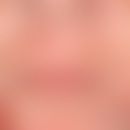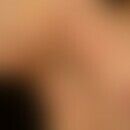Synonym(s)
HistoryThis section has been translated automatically.
DefinitionThis section has been translated automatically.
Rare (about 100 cases have been documented so far, a significantly higher number can be assumed) subtype of physical urticaria, in which the appearance of pinhead-sized, reddened, follicular papules in the contact area after water contact is typical. Often occurs only after prolonged contact with water (within 2-30 minutes after contact), see also aquagenic pruritus.
You might also be interested in
EtiopathogenesisThis section has been translated automatically.
Not clear. Formation of a histamine liberator by contact of water and sebum is discussed. To what extent an associated lactose intolerance is etiopathogenetically significant is still unclear.
An association between familial aquagenic urticaria and the Bernard-Soulier Syndrome (BSS) has been described sporadically. This is a rare autosomal recessive coagulation disorder characterized by a mutation of the GPIb-IX-V complex genes located on chromosomes 17p12, 22q11.2, 3q21, which code for a "platelet receptor" for von Willebrand factor (vWF) (Pitarch G et al. 2006; see below platelet). The connection is not clear.
ManifestationThis section has been translated automatically.
LocalizationThis section has been translated automatically.
The upper body is preferentially affected, rarely the face and lower extremities. Never occurring on Palmae and Plantae (absence of sebaceous glands). Only skin areas that have been in contact with water can develop skin lesions.
HistologyThis section has been translated automatically.
Superficial perivascular dermatitis with eosinophils, neutrophils, lymphocytes and some mast cells. Severe dermal edema.
DiagnosisThis section has been translated automatically.
The tests remain negative without contact with water.
Test by placing wet, body-temperature cloths on the skin for 20 minutes. The appearance of itchy wheals is considered a positive test result.
Differential diagnosisThis section has been translated automatically.
General therapyThis section has been translated automatically.
External therapyThis section has been translated automatically.
Radiation therapyThis section has been translated automatically.
Internal therapyThis section has been translated automatically.
Poor response to antihistamines. If necessary, try levocetirizine (e.g. Xusal) 1-2 tbl/day or desloratadine (e.g. Aerius) 1-2 tbl/day. Therapy trials with H2-blockers, acetylsalicylic acid, cholestyramine and iron substitution are described.
LiteratureThis section has been translated automatically.
- Bayle P et al (2003) Localized aquagenic urticaria: efficacy of a barrier cream. Contact dermatitis 49: 160-161
- Hedge E (1981) Water contact urticaria. dermatologist 32: 532-534
- Parker RK et al (1992) Aquagenic urticaria. Cutis 50: 283-284
- Pitarch G et al (2006) Familial aquagenic urticaria and bernard-soulier syndrome. Dermatology 212:96-97.
- Savoia A et al (2014) Spectrum of the mutations in Bernard-Soulier syndrome. Hum mutate 35:1033-1045
- Shelley WB, Rawnsley HM (1964) Aquagenic urticaria. Contact sensitivity reaction to water. JAMA 189: 895-898
- Treudler R et al (2002) Familial aquagenic urticaria associated with familial lactose intolerance. J Am Acad Dermatol 47: 611-613
- Wang F et al (2017) Aquagenic cutaneous disorders. J Dtsch Dermatol Ges 15:602-608.
Incoming links (6)
Platelet; Pruritus aquagener; Urtica; Water allergy; Water contact urticaria; Water urticaria;Outgoing links (16)
Acetylsalicylic acid; Antihistamines, systemic; Cold urticaria; Desloratadine; Glucorticosteroids topical; Levocetirizine; Macrocytic thrombopathy; Methylprednisolone; Papel; Platelet; ... Show allDisclaimer
Please ask your physician for a reliable diagnosis. This website is only meant as a reference.




